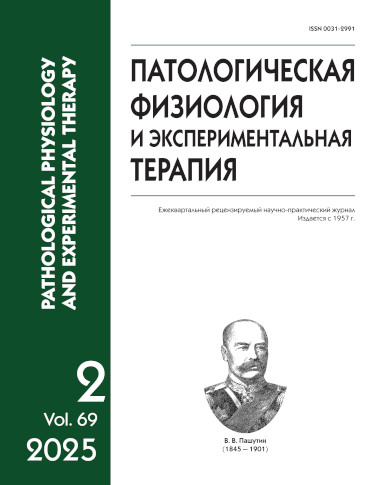Experimental application of a modified collagen conduit for reconstruction of a sciatic nerve defect in rats
Abstract
Background. Numerous methods and technologies have been used in the development and modification of constructions for the repair of nerve defects. One of these techniques is obtaining biopolymer-based conductive conduits. To increase the efficiency of peripheral nerve repair, various fillers are used, such as extracellular matrix (ECM)-based hydrogels. Aim: To evaluate the reparative effect of an ECM-based hydrogel as a filler for a collagen nerve conduit in an in vivo model of peripheral nerve injury.
Methods. The ECM-based hydrogel was obtained by alkaline hydrolysis of porcine dermis. Sciatic nerve defects were modeled in three groups of Wistar rats: group 1 (n=5), control, autografted defect; group 2 (n=5), defect reconstructed with a NeuraGen® collagen conduit (Integra, USA) with ECM-based hydrogel; group 3 (n=5), defect reconstructed with a NeuraGen® conduit without a filling. The reparative effect was evaluated by immunohistochemical staining to quantify the neurofilaments and motor fibers, and the extent of myelination in the proximal, medial, and distal fragments of the nerve.
Results. The immunohistochemical evaluation of the implants showed elevated values of the expression of myelin basic protein (MBP), choline acetyltransferase (ChAT), and neurofilaments (NF) in the proximal segment of the nerve in all animal groups. In the autograft group, the expression values for the analyzed proteins were significantly greater than in the other groups. However, in group 2, the expression of the immunohistochemical markers was greater than in group 3 along the entire length of the reconstructed nerve, indicating a beneficial effect of the ECM-based hydrogel modification in the nerve conduit.
Conclusion. The modification of the NeuraGen® collagen conduit with the ECM-based hydrogel enhanced the efficacy of the nerve tissue regeneration following the repair of peripheral nerve defects. The obtained hydrogel likely exerts a stimulatory effect on the growth of nerve fibers and enhances the migration and proliferation of Schwann cells, which underscores the need for further development and refinement of existing nerve conduits.
Downloads
References
2. Hunsberger J., Neubert J., Wertheim J.A., Allickson J., Atala A. Bioengineering priorities on a path to ending organ shortage. Current Stem Cell Reports. 2016; 2: 118-127.
3. Jo Y., Hwang S.H., Jang J. Employing extracellular matrix-based tissue engineering strategies for age-dependent tissue degenerations. International Journal of Molecular Sciences. 2021. 22(17): 9367.
4. Kim Y., Ko H., Kwon I.K., Shin K. Extracellular matrix revisited: roles in tissue engineering. International neurourology journal. 2016; 20(Suppl 1): S23.
5. Мелконян К.И., Козмай Я.А., Веревкин А.А., Русинова Т.В., Асякина А.С., Золотавина М.Л. Выбор оптимальной методики для получения различных форм биосовместимых ксенодермальных материалов. Современные технологии в медицине. 2022; 14(1): 34-43.
6. Naahidi S., Jafari M., Logan M., Wang Y., Yuan Y., Bae H. Biocompatibility of hydrogel-based scaffolds for tissue engineering applications. Biotechnology advances. 2017; 35(5): 530-544.
7. Edgar L., Pu T., Porter B., Aziz J.M., Pointe C.L., Asthana A., Regenerative medicine, organ bioengineering and transplantation. Journal of British Surgery. 2020; 107(7): 793-800.
8. Harris G.M., Madigan N.N., Lancaster K.Z., Enquist L.W., Windebank A.J., Schwartz J. Nerve guidance by a decellularized fibroblast extracellular matrix. Matrix Biology. 2017; 60: 176-189.
9. Щаницын И.Н., Иванов А.Н., Бажанов С.П., Нинель В.Г., Пучиньян Д.М., Норкин И.А. Стимуляция регенерации периферического нерва: современное состояние, проблемы и перспективы. Успехи физиологических наук. 2017; 48(3): 92-112.
10. Jahromi M., Razavi S., Bakhtiari A. The advances in nerve tissue engineering: From fabrication of nerve conduit to in vivo nerve regeneration assays. Journal of tissue engineering and regenerative medicine. 2019; 13(11): 2077-2100.
11. Raza C., Riaz H.A., Anjum R. Repair strategies for injured peripheral nerve. Life sciences. 2020; 243: 117308.
12. Cramer M.C., Badylak S.F. Extracellular matrix-based biomaterials and their influence upon cell behavior. Annals of biomedical engineering. 2020; 48(7): 2132-2153.
13. Fornasari B.E., Carta G., Gambarotta G., Raimondo S. Natural-based biomaterials for peripheral nerve injury repair. Frontiers in bioengineering and biotechnology. 2020; 8: 554257.
14. Deng P., Chen F., Zhang H., Chen Y., Zhou J. Multifunctional double‐layer composite hydrogel conduit based on chitosan for peripheral nerve repairing. Advanced Healthcare Materials. 2022; 11(13): 2200115.
15. Crook B.S., Cullen M.M., Pidgeon T.S. The Role of Tissue Engineering and Three-Dimensional–Filled Conduits in Bridging Nerve Gaps: A Review of Recent Advancements. Journal of Hand Surgery Global Online. 2024; 1-5.
16. Bousalis D., McCrary M.W., Vaughn N., Hlavac N., Evering A. et al. Decellularized peripheral nerve as an injectable delivery vehicle for neural applications. Journal of Biomedical Materials Research Part A. 2022; 10(3): 595-611.
17. Huang Z., Kankowski S., Ertekin E., Almog M., Nevo Z., Rochkind S., Modified hyaluronic acid-laminin-hydrogel as luminal filler for clinically approved hollow nerve guides in a rat critical defect size model. International Journal of Molecular Sciences. 2021; 22(12): 6554.
18. Meyer C., Wrobel S., Raimondo S., Rochkind S., Heimann C., Shahar A. et al. Peripheral nerve regeneration through hydrogel-enriched chitosan conduits containing engineered Schwann cells for drug delivery. Cell transplantation. 2016; 25(1): 159-182.






